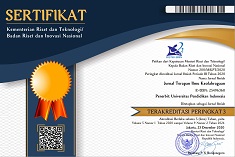Fatigue Effect on Attack Accuracy and Kinematic Variables Performance Lunge Action In Fencing
Abstract
Keywords
References
Baltzopoulos, Vasilios. 2008. Biomechanical Evaluation of Movement in Sport and Exercise. Human Kinetic
Burkett, Brendan and Gerald A. Carr. 2015. Sport Mechanics for Coaches. Human Kinetic
Bottoms, L., Greenhalgh, A., & Gregory, K. (2013). The effect of caffeine ingestion on skill maintenance and fatigue in epee fencers, (February). https://doi.org/10.1080/02640414.20 13.764466
Bottoms, L., Greenhalgh, A., & Sinclair, J. (2013). Kinematic determinants of weapon velocity during the fencing lunge in experienced épée fencers, (December), 1–6. https://doi.org/10.5277/abb130414
Cronin, J., Mcnair, P., & Marshall, R. (2003). Lunge performance and its determinants, (October 2014), 37–41.https://doi.org/10.1080/0264041031000070958
Dezman, Zachary D. W., Eric H. Ledet, and Hamish A. Kerr. 2013. “Neck Strength Imbalance Correlates With Increased Head Acceleration in Soccer Heading.” Sports Health 5(4):320–26.
Evans, D. R., Boggero, I. A., & Segerstrom, S. C. (2015). The Nature of Self-Regulatory Fatigue and “ Ego Depletion ”: Lessons From Physical Fatigue,(August).https://doi.org/10.1177/1088868315597841
Himanshu, Thukral, Chatterjee Tirthankar, Bhattacharyya Debojyoti, Chatterjee Subhojit, Sen Suranjana, and Pal Sudan Madhu. 2017. “Evaluation and Assessment of Leg Muscle Activity and Fatigue Accross Two Popular Step Test Exercises.” 13.
Kurniawan, T. (2022). Effects of Mental Fatigue on Visual Scanning Speed in First-Person Shooter Esports Athletes. ASEAN Journal for Sport Development and Peace, 2(1), 57–63.
Maher, Monica E., Michael Hutchison, Michael Cusimano, Paul Comper, and Tom A. Schweizer. 2014. “Concussions and Heading in Soccer: A Review of the Evidence of Incidence, Mechanisms, Biomarkers and Neurocognitive Outcomes.” Brain Injury 28(3):271–85. Superceded by 916427733 ] Sports Biomechanics Tibial shock measured during the fencing lunge : the influence of footwear, (June). https://doi.org/10.1080/14763141.2010.491161
Moir, Gavin L. 2018. “Three Different Methods of Calculating Vertical Jump Height from Force Platform Data in Men and Women.” Measurement in Physical Education and Exercise Science 12(4):207–18.
Mohr, M., I. Mujika, J. Santisteban, M. B. Randers, R. Bischoff, R. Solano, A. Hewitt, A. Zubillaga, E. Peltola, and P. Krustrup. 2010. “Examination of Fatigue Development in Elite Soccer in a Hot Environment: A MultiExperimentalApproach.” Scandinavian Journal of Medicine and Science in Sports 20(SUPPL.3):125–32.
Mohr, Magni, Peter Krustrup, and Jens Bangsbo. 2015. “Fatigue in Soccer: A Brief Review.” Journal of Sports Sciences 23(6):593–99.
Ntai, A., Zahou, F., Paradisis, G., Smirniotou, A., & Tsolakis, C. (2017). Anthropometric parameters and leg power performance in fencing. Age , sex and Caractéristiquesanthropométriques et puissance en escrime : Science et Sports.https://doi.org/10.1016/j.scispo.2016.06.011
Phillips, S. (1989). Fatigue in sport and exercise. Journal of Chemical Information and Modeling (Vol. 53). https://doi.org/10.1017/CBO9781107415324.004
Phillips, S. (2016). Fatigue in sport and exercise. Choice Reviews Online (Vol.53).https://doi.org/10.5860/choice.194034
Rusdiana, Ray, H. R. D., & Umaran., et al. (2017). My IOPscience Fatigue Impact to Mechanical Movement of Maximal Instep Kicking in Soccer This content has been downloaded from IOPscience . Please scroll down to see the full text ., (March).
Rusdiana, A., Abdullah, M. R. Bin, Syahid, A. M., Haryono, T., & Kurniawan, T. (2021). Badminton overhead backhand and forehand smashes: a biomechanical analysis approach. Journal of Physical Education and Sport, 21(4), 1722–1727.
Rusdiana, A., Darmawan, M. S., Syahid, A. M., & Kurniawan, T. (2020). Biomechanical Analysis of an Overhead Baseball Throwing Movement Associated with a Cardiorespiratory Fatigue Effect. The Open Sports Sciences Journal, 13(1).
Rusdiana, A., Subarjah, H., Imanudin, I., Kusdinar, Y., M Syahid, A., & Kurniawan, T. (2020). Effect of Fatigue on Biomechanical Variable Changes in Overhead Badminton Jump Smash. Annals of Applied Sport Science, 1–8.
Sinclair, J., Bottoms, L., Taylor, K., & Greenhalgh, A. (2010). Tibial shock measured during the fencing lunge : The influence of footwear This article was downloaded by : [ EBSCOHost EJS Content Distribution
Sudarna, N. S., Rusdiana, A., Imanudin, I., Umaran, U., & Kurniawan, T. (2022). Analisis Volume Permainan Berdasarkan Posisi Pemain di UKM Bola Basket Putra UPI. Jurnal Terapan Ilmu Keolahragaan, 7(2), 1–5.
Tsolakis, C. (2014). Anthropometric , flexibility , strength-power , and sport-specific correlates in elite fencing, (February). https://doi.org/10.2466/pms.110.3c.1 015-1028
DOI: https://doi.org/10.17509/jtikor.v7i1.41906
Refbacks
- There are currently no refbacks.
Copyright (c) 2022

This work is licensed under a Creative Commons Attribution-NonCommercial-ShareAlike 4.0 International License.





